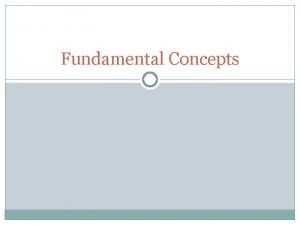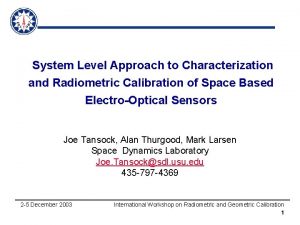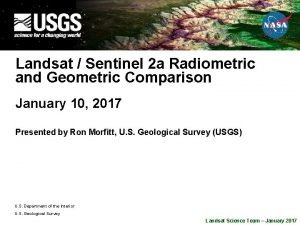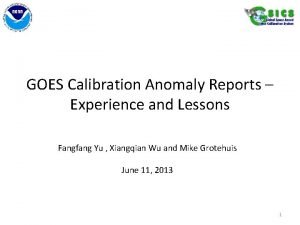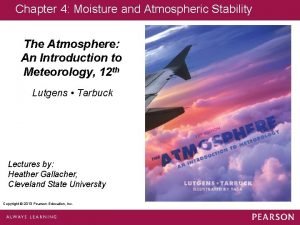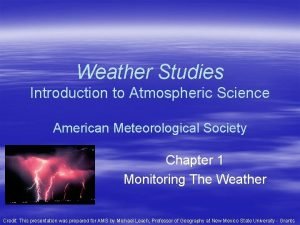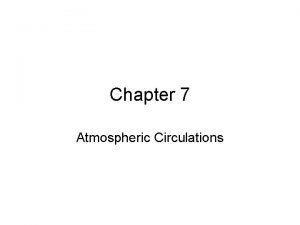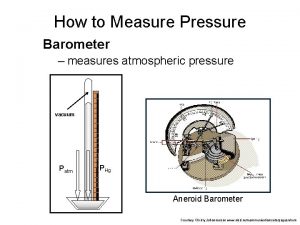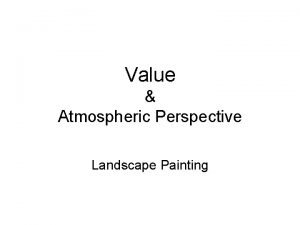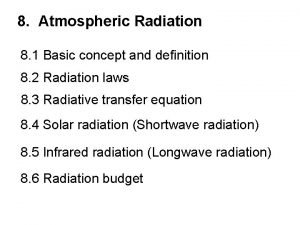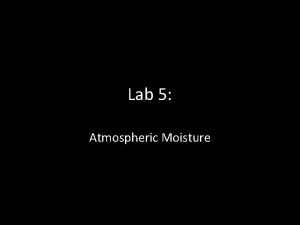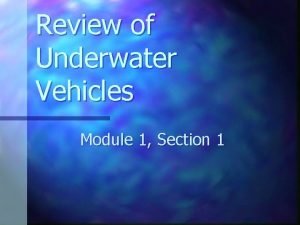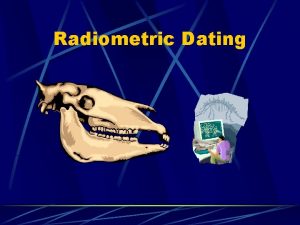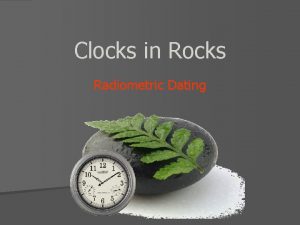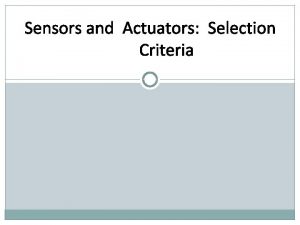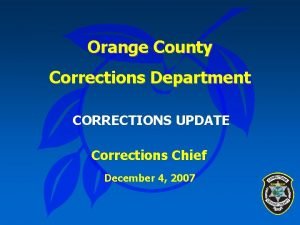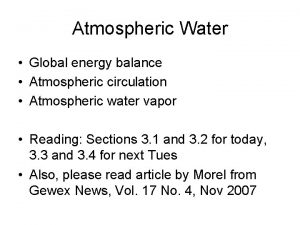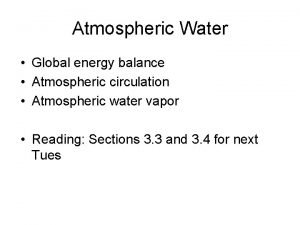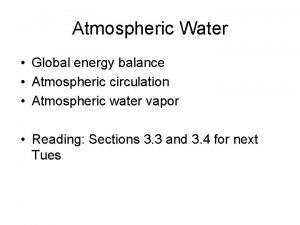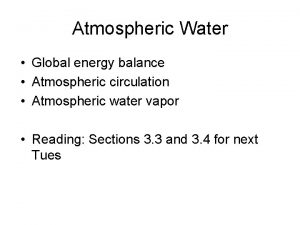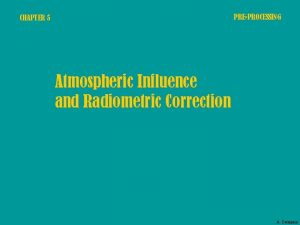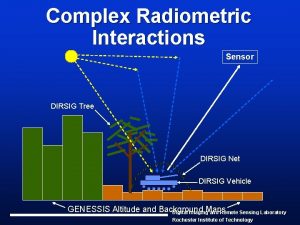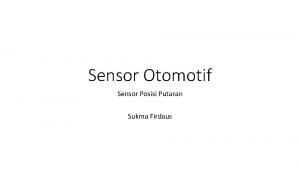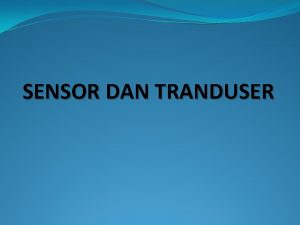Class 8 Radiometric Corrections Sensor Corrections Atmospheric Corrections


















- Slides: 18

Class 8: Radiometric Corrections Sensor Corrections Atmospheric Corrections Conversion from DN to reflectance BRDF Corrections

Two types of corrections: Geometric Corrections (class 5) Radiometric Corrections (class 8) Remote sensing images are contaminated by various radiative processes. The need to correct them varies with the applications and sensors used. Every time two images need to be combined (e. g. , in a mosaic) or compared, the corrections become obviously important.

Radiometric Correction is made on the brightness (gray level) values of the image. Source of errors to be corrected: atmospheric degradation sensor malfunctions Illumination-view geometry Corrections are usually different for each band, and in theory for each pixel Attempts to correct data may themselves introduce errors Campbell 10. 4

Radiometric Corrections 1. • • 2. • • 3. 4. 5. Correction for detector errors Line drop Destriping Atmospheric corrections Histogram adjustment Atmospheric radiative transfer models Conversion from DN to radiance Conversion from radiance to reflectance BRDF corrections

Sensor corrections Line Dropout 43 40 0 38 Solution: 43 40 39 38 47 46 0 40 51 50 0 42 57 54 0 50 Mean from above and below pixels 47 46 43 40 51 50 46 42 57 54 52 50 Or use other spectral band Images: Lillesand-Kiefer Campbell 10. 4

Sensor corrections Striping Local averaging Normalization Images: Lillesand-Kiefer Campbell 10. 4

Atmospheric Corrections 1) Histogram adjustment • Clear sky • Hazy sky 2) Physical Models Campbell 10. 4

Simple Atmospheric Corrections – Histogram Adjustment Clear Atmosphere Narrow range of brightness values Small atmospheric contribution to brightness Brightness values Cloud shadowed region and water bodies have very low reflectance in infrared bands. This should give a peak near zero on the histogram. The shifted peak is due to the low reflectance regions with atmospheric scattering. A correction can be obtain by removing this value from all pixels. This method is called the Histogram Minimum Method (HMM) Darkest values near zero Campbell 10. 4

Simple Atmospheric Corrections – Histogram Adjustment Hazy Atmosphere Wide range of brightness values Added brightness of atmosphere In this case, the minimum value is higher, and the histogram shape has changed Brightness values Darkest values far from zero Campbell 10. 4

Atmospheric Correction Models Physical models simulate the physical process of scattering at the level of individual particles and molecules Absorption by gases scattering by aerosols LOWTRAN 7 MODTRAN CAM 5 S, 6 S Complex models that need many meteorological data as input. The data may not always be available Campbell 10. 4

Atmospheric Correction Models Second Simulation of the Satellite Signal in the Solar Spectrum: 6 S Input file example (Saskatchewan study site; Landsat imagery): 7 9 02 17. 14 -105. 22 53. 85 2 1 30 -0. 59 -1000 29 0 0 1 -2. 0 (landsat TM) (month, day, hour, long, lat) (mid lat summer) (continental) (visibility, km) (TARGET ALTITUDE IN KM) (SATELLITE CASE) (Landsat band 1) (HOMOGENEOUS CASE) (NO BRDF effect) (uniform target = vegetation) (no atm. correction)

ASAS Konza prairie reflectance spectrum Atmospheric Correction Models 6 S corrected reflectance Top of atmosphere reflectance ASAS band central wavelength (nm) Vermote et al. , 1997

From DN to Radiance to Reflectance LANDSAT TM Spectral Band 1 2 3 4 5 7 Calibration Gain Coefficient (counts/(W/m 2/sr/mm)) G=(-3. 58 E-05)*D+1. 376 G=(-2. 10 E-05)*D+0. 737 G=(-1. 04 E-05)*D+0. 932 G=(-3. 20 E-06)*D+1. 075 G=(-2. 64 E-05)*D+7. 329 G=(-3. 81 E-04)*D+16. 02 Characteristic Solar Wavelength Irradiance (mm) (W/m 2/mm) 0. 4863 0. 5706 0. 6607 0. 8382 1. 677 2. 223 1959. 2 1827. 4 1550. 0 1040. 8 220. 75 74. 960 D = days since launch Radiance = (DN - Offset)/Gain Reflectance = p. Radiance/Incident Solar Irradiance=Solar Irradiance *cos(SZA) Source: CCRS Web site

If the input signal exceeds the amount for which the sensor was designed, the system response will become non-linear or reach the saturation level. This is a common occurrence in land remote sensing systems when they image bright clouds and/or snow cover, for example. Saturation y (DN) Non-Linear Region y = a. x + b (DN = gain*Radiance + offset) Offset b Input Value x (radiance) Source: CCRS Web site

Atmospheric Corrections Ltot= radiance measured by the sensor r = reflectance of the target E = irradiance on the target T = transmissivity of the atmosphere Lp= path radiance (radiance due to the atmosphere) L & K 7. 2

Atmospheric Corrections E 0 cos s E = --------d 2 E 0 = solar irradiance at the mean Earth-Sun distance s =solar zenith angle d = relative deviation of Earth-Sun distance from the mean distance at the time of imaging L & K 7. 2

Bidirectional Reflectance Distribution Function (BRDF) Correction Structures like trees cast shadows that change the amount of light that reaches a sensor depending on its view zenith angle To compare pixel reflectance from different images, or even different part of an image, the target (pixel) reflectance must be measured under the same view and solar geometry. Solar Zenith Angle (SZA) Sensor View Zenith Angle (VZA)

Some BRDF models CCRS uses a modification of Roujean’s model for BRDF corrections of AVHRR data (Roujean + hotspot from 4 -Scale, Chen and Cihlar, 1997) GORT (Li and Strahler) 4 -Scale (Chen and Leblanc)
 Resolution characteristics
Resolution characteristics Carbon dating differential equation
Carbon dating differential equation Radiometric calibration
Radiometric calibration Radiometric error
Radiometric error üspace
üspace Umdf sensor
Umdf sensor Atmospheric physics lecture notes
Atmospheric physics lecture notes Atmospheric stability
Atmospheric stability Atmospheric vortex engine
Atmospheric vortex engine Weather studies introduction to atmospheric science
Weather studies introduction to atmospheric science Single cell model of atmospheric circulation
Single cell model of atmospheric circulation Atmospheric pressure
Atmospheric pressure Biomes
Biomes Landscape atmospheric perspective
Landscape atmospheric perspective Stellar heaven
Stellar heaven Atmospheric carbon dioxide graph
Atmospheric carbon dioxide graph Atmospheric
Atmospheric Lab 5 atmospheric moisture
Lab 5 atmospheric moisture Atmospheric diving suit
Atmospheric diving suit
